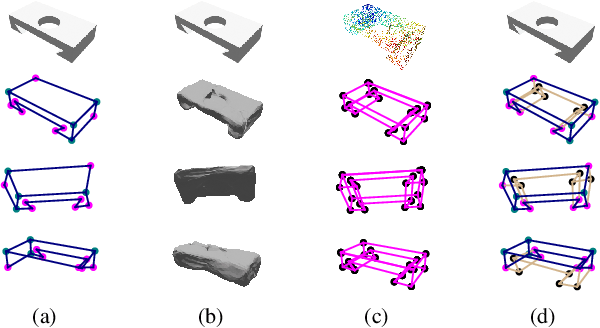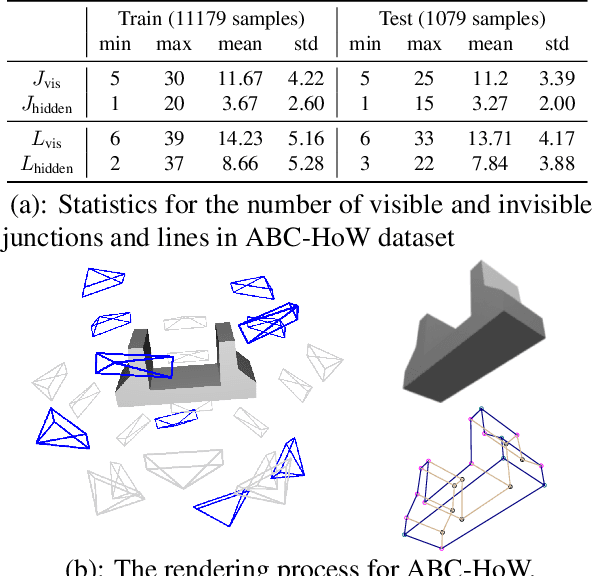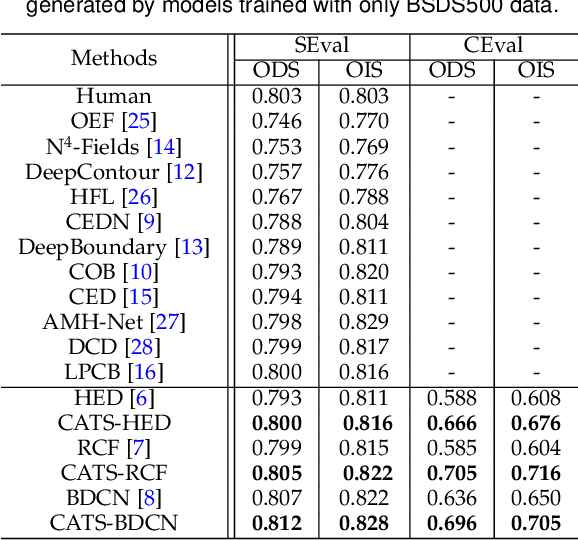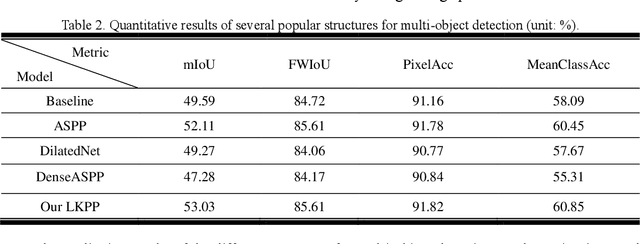Xianwei Zheng
CoMatcher: Multi-View Collaborative Feature Matching
Apr 02, 2025Abstract:This paper proposes a multi-view collaborative matching strategy for reliable track construction in complex scenarios. We observe that the pairwise matching paradigms applied to image set matching often result in ambiguous estimation when the selected independent pairs exhibit significant occlusions or extreme viewpoint changes. This challenge primarily stems from the inherent uncertainty in interpreting intricate 3D structures based on limited two-view observations, as the 3D-to-2D projection leads to significant information loss. To address this, we introduce CoMatcher, a deep multi-view matcher to (i) leverage complementary context cues from different views to form a holistic 3D scene understanding and (ii) utilize cross-view projection consistency to infer a reliable global solution. Building on CoMatcher, we develop a groupwise framework that fully exploits cross-view relationships for large-scale matching tasks. Extensive experiments on various complex scenarios demonstrate the superiority of our method over the mainstream two-view matching paradigm.
* 15 pages, 7 figures, to be published in CVPR 2025
Deferred Poisoning: Making the Model More Vulnerable via Hessian Singularization
Nov 06, 2024Abstract:Recent studies have shown that deep learning models are very vulnerable to poisoning attacks. Many defense methods have been proposed to address this issue. However, traditional poisoning attacks are not as threatening as commonly believed. This is because they often cause differences in how the model performs on the training set compared to the validation set. Such inconsistency can alert defenders that their data has been poisoned, allowing them to take the necessary defensive actions. In this paper, we introduce a more threatening type of poisoning attack called the Deferred Poisoning Attack. This new attack allows the model to function normally during the training and validation phases but makes it very sensitive to evasion attacks or even natural noise. We achieve this by ensuring the poisoned model's loss function has a similar value as a normally trained model at each input sample but with a large local curvature. A similar model loss ensures that there is no obvious inconsistency between the training and validation accuracy, demonstrating high stealthiness. On the other hand, the large curvature implies that a small perturbation may cause a significant increase in model loss, leading to substantial performance degradation, which reflects a worse robustness. We fulfill this purpose by making the model have singular Hessian information at the optimal point via our proposed Singularization Regularization term. We have conducted both theoretical and empirical analyses of the proposed method and validated its effectiveness through experiments on image classification tasks. Furthermore, we have confirmed the hazards of this form of poisoning attack under more general scenarios using natural noise, offering a new perspective for research in the field of security.
PolyRoom: Room-aware Transformer for Floorplan Reconstruction
Jul 15, 2024Abstract:Reconstructing geometry and topology structures from raw unstructured data has always been an important research topic in indoor mapping research. In this paper, we aim to reconstruct the floorplan with a vectorized representation from point clouds. Despite significant advancements achieved in recent years, current methods still encounter several challenges, such as missing corners or edges, inaccuracies in corner positions or angles, self-intersecting or overlapping polygons, and potentially implausible topology. To tackle these challenges, we present PolyRoom, a room-aware Transformer that leverages uniform sampling representation, room-aware query initialization, and room-aware self-attention for floorplan reconstruction. Specifically, we adopt a uniform sampling floorplan representation to enable dense supervision during training and effective utilization of angle information. Additionally, we propose a room-aware query initialization scheme to prevent non-polygonal sequences and introduce room-aware self-attention to enhance memory efficiency and model performance. Experimental results on two widely used datasets demonstrate that PolyRoom surpasses current state-of-the-art methods both quantitatively and qualitatively. Our code is available at: https://github.com/3dv-casia/PolyRoom/.
Stratified Avatar Generation from Sparse Observations
Jun 03, 2024Abstract:Estimating 3D full-body avatars from AR/VR devices is essential for creating immersive experiences in AR/VR applications. This task is challenging due to the limited input from Head Mounted Devices, which capture only sparse observations from the head and hands. Predicting the full-body avatars, particularly the lower body, from these sparse observations presents significant difficulties. In this paper, we are inspired by the inherent property of the kinematic tree defined in the Skinned Multi-Person Linear (SMPL) model, where the upper body and lower body share only one common ancestor node, bringing the potential of decoupled reconstruction. We propose a stratified approach to decouple the conventional full-body avatar reconstruction pipeline into two stages, with the reconstruction of the upper body first and a subsequent reconstruction of the lower body conditioned on the previous stage. To implement this straightforward idea, we leverage the latent diffusion model as a powerful probabilistic generator, and train it to follow the latent distribution of decoupled motions explored by a VQ-VAE encoder-decoder model. Extensive experiments on AMASS mocap dataset demonstrate our state-of-the-art performance in the reconstruction of full-body motions.
Learning Deformable Hypothesis Sampling for Accurate PatchMatch Multi-View Stereo
Dec 26, 2023Abstract:This paper introduces a learnable Deformable Hypothesis Sampler (DeformSampler) to address the challenging issue of noisy depth estimation for accurate PatchMatch Multi-View Stereo (MVS). We observe that the heuristic depth hypothesis sampling modes employed by PatchMatch MVS solvers are insensitive to (i) the piece-wise smooth distribution of depths across the object surface, and (ii) the implicit multi-modal distribution of depth prediction probabilities along the ray direction on the surface points. Accordingly, we develop DeformSampler to learn distribution-sensitive sample spaces to (i) propagate depths consistent with the scene's geometry across the object surface, and (ii) fit a Laplace Mixture model that approaches the point-wise probabilities distribution of the actual depths along the ray direction. We integrate DeformSampler into a learnable PatchMatch MVS system to enhance depth estimation in challenging areas, such as piece-wise discontinuous surface boundaries and weakly-textured regions. Experimental results on DTU and Tanks \& Temples datasets demonstrate its superior performance and generalization capabilities compared to state-of-the-art competitors. Code is available at https://github.com/Geo-Tell/DS-PMNet.
Shape Anchor Guided Holistic Indoor Scene Understanding
Sep 20, 2023Abstract:This paper proposes a shape anchor guided learning strategy (AncLearn) for robust holistic indoor scene understanding. We observe that the search space constructed by current methods for proposal feature grouping and instance point sampling often introduces massive noise to instance detection and mesh reconstruction. Accordingly, we develop AncLearn to generate anchors that dynamically fit instance surfaces to (i) unmix noise and target-related features for offering reliable proposals at the detection stage, and (ii) reduce outliers in object point sampling for directly providing well-structured geometry priors without segmentation during reconstruction. We embed AncLearn into a reconstruction-from-detection learning system (AncRec) to generate high-quality semantic scene models in a purely instance-oriented manner. Experiments conducted on the challenging ScanNetv2 dataset demonstrate that our shape anchor-based method consistently achieves state-of-the-art performance in terms of 3D object detection, layout estimation, and shape reconstruction. The code will be available at https://github.com/Geo-Tell/AncRec.
Holistic Geometric Feature Learning for Structured Reconstruction
Sep 18, 2023Abstract:The inference of topological principles is a key problem in structured reconstruction. We observe that wrongly predicted topological relationships are often incurred by the lack of holistic geometry clues in low-level features. Inspired by the fact that massive signals can be compactly described with frequency analysis, we experimentally explore the efficiency and tendency of learning structure geometry in the frequency domain. Accordingly, we propose a frequency-domain feature learning strategy (F-Learn) to fuse scattered geometric fragments holistically for topology-intact structure reasoning. Benefiting from the parsimonious design, the F-Learn strategy can be easily deployed into a deep reconstructor with a lightweight model modification. Experiments demonstrate that the F-Learn strategy can effectively introduce structure awareness into geometric primitive detection and topology inference, bringing significant performance improvement to final structured reconstruction. Code and pre-trained models are available at https://github.com/Geo-Tell/F-Learn.
HoW-3D: Holistic 3D Wireframe Perception from a Single Image
Aug 19, 2022



Abstract:This paper studies the problem of holistic 3D wireframe perception (HoW-3D), a new task of perceiving both the visible 3D wireframes and the invisible ones from single-view 2D images. As the non-front surfaces of an object cannot be directly observed in a single view, estimating the non-line-of-sight (NLOS) geometries in HoW-3D is a fundamentally challenging problem and remains open in computer vision. We study the problem of HoW-3D by proposing an ABC-HoW benchmark, which is created on top of CAD models sourced from the ABC-dataset with 12k single-view images and the corresponding holistic 3D wireframe models. With our large-scale ABC-HoW benchmark available, we present a novel Deep Spatial Gestalt (DSG) model to learn the visible junctions and line segments as the basis and then infer the NLOS 3D structures from the visible cues by following the Gestalt principles of human vision systems. In our experiments, we demonstrate that our DSG model performs very well in inferring the holistic 3D wireframes from single-view images. Compared with the strong baseline methods, our DSG model outperforms the previous wireframe detectors in detecting the invisible line geometry in single-view images and is even very competitive with prior arts that take high-fidelity PointCloud as inputs on reconstructing 3D wireframes.
Unmixing Convolutional Features for Crisp Edge Detection
Nov 19, 2020



Abstract:This paper presents a context-aware tracing strategy (CATS) for crisp edge detection with deep edge detectors, based on an observation that the localization ambiguity of deep edge detectors is mainly caused by the mixing phenomenon of convolutional neural networks: feature mixing in edge classification and side mixing during fusing side predictions. The CATS consists of two modules: a novel tracing loss that performs feature unmixing by tracing boundaries for better side edge learning, and a context-aware fusion block that tackles the side mixing by aggregating the complementary merits of learned side edges. Experiments demonstrate that the proposed CATS can be integrated into modern deep edge detectors to improve localization accuracy. With the vanilla VGG16 backbone, in terms of BSDS500 dataset, our CATS improves the F-measure (ODS) of the RCF and BDCN deep edge detectors by 12% and 6% respectively when evaluating without using the morphological non-maximal suppression scheme for edge detection.
ELKPPNet: An Edge-aware Neural Network with Large Kernel Pyramid Pooling for Learning Discriminative Features in Semantic Segmentation
Jun 27, 2019



Abstract:Semantic segmentation has been a hot topic across diverse research fields. Along with the success of deep convolutional neural networks, semantic segmentation has made great achievements and improvements, in terms of both urban scene parsing and indoor semantic segmentation. However, most of the state-of-the-art models are still faced with a challenge in discriminative feature learning, which limits the ability of a model to detect multi-scale objects and to guarantee semantic consistency inside one object or distinguish different adjacent objects with similar appearance. In this paper, a practical and efficient edge-aware neural network is presented for semantic segmentation. This end-to-end trainable engine consists of a new encoder-decoder network, a large kernel spatial pyramid pooling (LKPP) block, and an edge-aware loss function. The encoder-decoder network was designed as a balanced structure to narrow the semantic and resolution gaps in multi-level feature aggregation, while the LKPP block was constructed with a densely expanding receptive field for multi-scale feature extraction and fusion. Furthermore, the new powerful edge-aware loss function is proposed to refine the boundaries directly from the semantic segmentation prediction for more robust and discriminative features. The effectiveness of the proposed model was demonstrated using Cityscapes, CamVid, and NYUDv2 benchmark datasets. The performance of the two structures and the edge-aware loss function in ELKPPNet was validated on the Cityscapes dataset, while the complete ELKPPNet was evaluated on the CamVid and NYUDv2 datasets. A comparative analysis with the state-of-the-art methods under the same conditions confirmed the superiority of the proposed algorithm.
 Add to Chrome
Add to Chrome Add to Firefox
Add to Firefox Add to Edge
Add to Edge